Were-Antelopes, Haunted Cabins, and the Horror of Retail: The Year’s Best Horror Stories: Series VII (1979), edited by Gerald W. Page
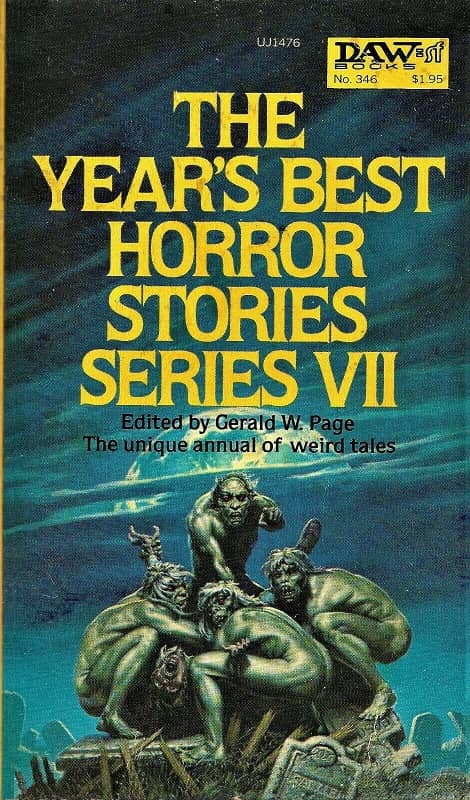 |
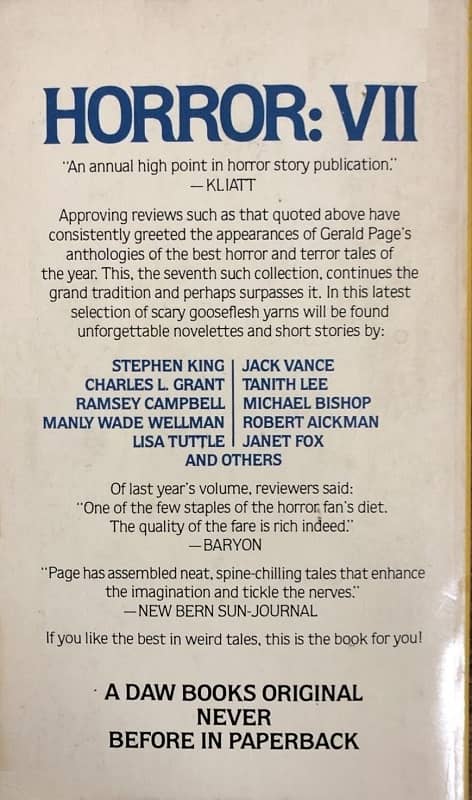 |
The Year’s Best Horror Stories: Series VII (DAW, July 1979). Cover by Michael Whelan
The Year’s Best Horror Stories: Series VII was the seventh volume in DAW’s Year’s Best Horror Stories, published in 1979. This was the fourth and final installment edited by horror author and editor Gerald W. Page (1939–). Given the strength of his anthologies, I doubt that Page was let go; but I don’t know why this was his last. Perhaps he returned to his own writing.
Michael Whelan’s (1950–) artwork appears for a fifth time in a row on the cover. His subject matter was quite eclectic for DAW, including this depiction of a grisly ghoul attack, one presumably interrupted by you or I the reader. It is a pretty terrifying and mesmerizing cover. I wonder if there’s not some humor mixed in as well. The foremost tombstone bears the name Carter. Is this a jibe at writer and editor-extraordinaire Lin Carter, editor of the competing Year’s Best Fantasy volumes? Or a political comment towards President Jimmy Carter?
The Year’s Best Horror Stories: Series VII includes fourteen stories: five from professional magazines, four from fanzines, three from books, and two originals. Gerald Page’s picks continued to rest primarily upon American males. There are three women: Janet Fox, Tanith Lee, and Lisa Tuttle, and a total of three Brits: Ramsey Campbell, Robert Aickman, and Tanith Lee. One story, by Jack Vance, was more than a decade old — another interesting choice for a Year’s Best but, as Page explains in the forward to Vance’s story, it was a fairly unknown Vance story that had recently reemerged.
I have been continually impressed at the overall quality of DAW’s Year’s Best Horror. However what qualifies as “horror,” in my opinion, overly varies. Gerald Page was a stronger and more consistent chooser of horror than Richard Davis, the British editor of the first three volumes. But even Page sometimes included stories that, in terms of being horrific, were so-so. Though a good addition to the series, this volume was not my favorite.
One of the more-OK contributions here was Dennis Etchison’s “The Pitch.” We sadly lost Etchison in 2019. He appeared in the last volume and I know he has a fairly big reputation in the field, but so far I have not found his work to my liking. “The Pitch” is not incredibly scary, but has sort of a nasty climactic twist. Partly clever, partly wish-fulfillment, if you’ve ever worked a retail job. “The Pitch” may satisfy a morbid desire on the part of some, but it does not, I think, really count as horror.
Another good entry, but again not all that horrific, was Stephen King’s “Night of the Tiger,” an interesting piece about a carnival with a mean tiger trainer. I also enjoyed Charles Saunders’ “Amma,” an African-style “were-antelope” tale. I’ve heard a lot about Saunders and I really liked this story, but it was not very frightening.
A few other entries were also good, and somewhat scary, but had wrapped up predictably. I usually love Manley Wade Wellman but his vampire tale “Chastel,” one of the two original stories, had an ending I could see coming. There were a couple of creepy bits, though. Lisa Tuttle’s “In the Arcade” concerns a woman who wakes up to find everyone around her is dead or “turned off.” But the Twilight Zone ending was unsurprising. Again, a good story with a few good scares, but predictable.
Tanith Lee’s “Sky Tiger” was an interesting Asian fairy tale. It included a ghost, but still wasn’t very scary. I also really liked Darrel Schweitzer’s “Divers Hands,” a fantasy story about warriors who have lost limbs in battle. Again, some horrific parts, but not very horrific overall.
Tales from the Nightside by Charles L. Grant (Arkham House, 1981). Cover by Michael Whelan
One of my favorite stories in this volume was Charles Grant’s “Hear Me Now, My Sweet Abbey Rose.” I’ve been impressed with all of the Grant entries in this series. So much so I tracked down a copy of his 1981 collection Tales from the Nightside, though I haven’t read it yet.
Grant’s writing is superb, particularly his characterization. His characters feel very real and his character dialogue genuine. Grant’s scares tend to be somewhat ambiguous, which normally I don’t care for. But you find yourself often so very invested due to his excellent storytelling. The chilling parts are effective primarily because of his ability to suck you in.
“Hear Me Now, My Sweet Abbey Rose” follows a middle-age couple and their three college-age daughters during a family vacation at a cabin. The girls get mixed up with some local frat-boy-1980s-movie bullies. Dad takes care of the boys. But these vicious punks return to the cabin for some remorseless revenge. The “revenge” is actually quite surprising, and the effects are horrific. Grant tries to turn the very ending into something of a ghost story, but I think the story stood well enough without this maudlin ending. Nevertheless, a magnificent tale.
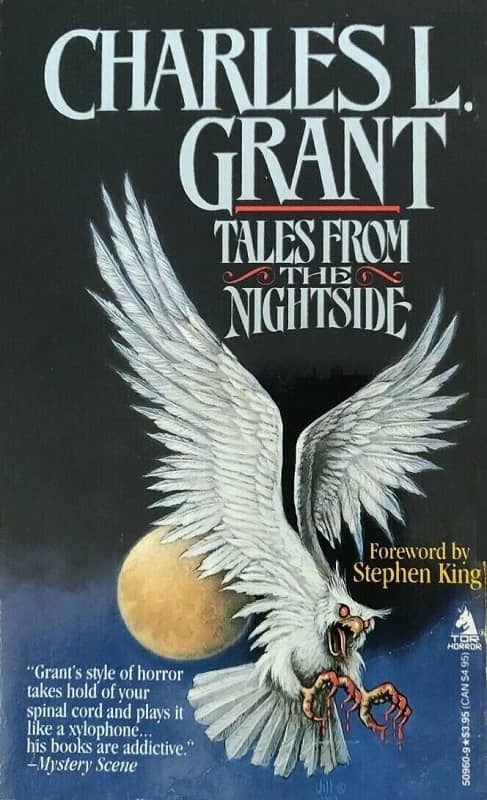 |
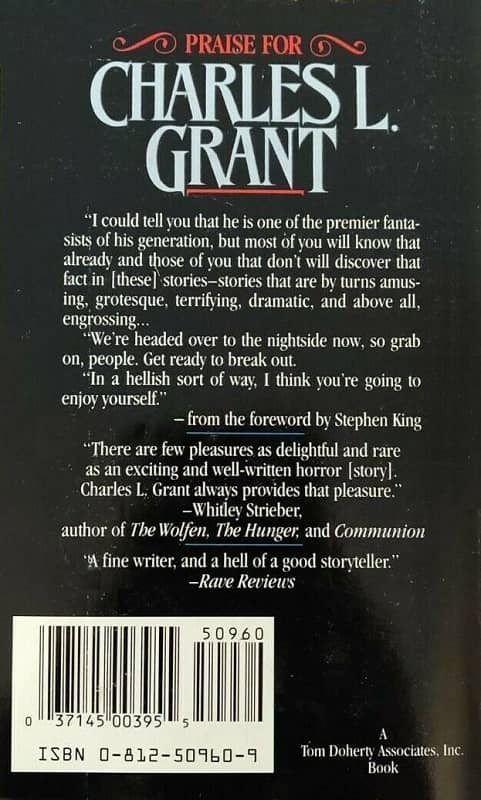 |
Paperback edition of Tales from the Nightside (Tor, December 1990). Cover by Jill Bauman
The clear gem of The Year’s Best Horror Stories: Series VII though was Robert Aickman’s “Marriage.” I have read only a little of Aickman. In some ways, I think of him as more of a longer-winded Ramsey Campbell. British horror authors like Campbell, Aickman, and even the great M. R. James, are usually not my cup of tea. Their story-telling tends to stretch out, and their British-isms are often difficult to understand.
But here Aickman is actually compelling on both of these counts. I can usually understand Aickman’s British-isms, even when I don’t get the reference. For example, when two characters are trying to remember the name of some actor’s spouse, the following dialogue plays out:
“Isn’t she married to a man named Souchong?”
“Heisen,” said Helen.
“I thought it was some kind of tea.” [p. 219]
I’m not familiar with a tea brand called Souchong or Heisen, but I can relate. I think that’s pretty outstanding cross-cultural writing.
Also, in terms of pacing, if Aickman’s stories were made into movies, they’d probably be classified as slow burn, psychological horrors. Those can be great movies, but on the page they can be slogs to get through. Ever read F. Marion Crawford or Sheridan Le Fanu? (Great authors, but a very different pace.)
“Marriage” is only my third Aickman, but his slow-build is full of potency and tension. Things seem just “not right,” and continue in that vein to the end. And the ambiguity of the finale not only feels right, it feels rewarding.
“Marriage” — as best as I can understand it — focuses on Laming Gatestead and his relationship with a young, properly British middle-class woman named Helen Black. Laming is a bachelor, still living at home with “Mumsey.” He and Helen meet at the local theatre and realize they both have a deep love of the performing arts. Their prim and proper romance continues on similar dates until Laming is invited to supper, where Helen’s roommate, Ellen Brown, makes the dinner for them. This is where things get interesting.
Where Helen Black is described as somewhat attractive, Ellen Brown is much younger and much more striking. The tension, at least within Laming’s mind, ratchets up. Ellen eventually lures Laming into some clandestine trysts. But weirdly, Laming sometimes sees Helen Black watching he and Ellen in the act. And it’s never made clear if he’s simply imagining it (with a guilty conscious), or actually seeing it. And Ellen’s behavior doesn’t reveal whether she actually sees anything or not.
The tension, weirdness, and ambiguity escalate to the very end where it’s not completely clear if Laming has ever had a relationship with any woman, or if this has all been in his head. Don’t Helen Black and Ellen Brown sound like suspiciously similar names for two roommates?
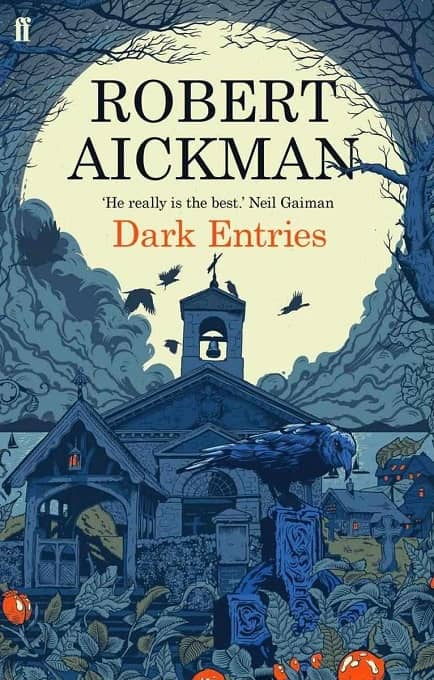 |
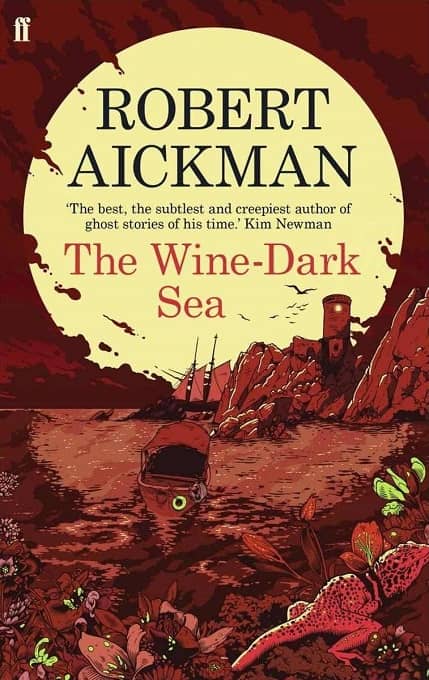 |
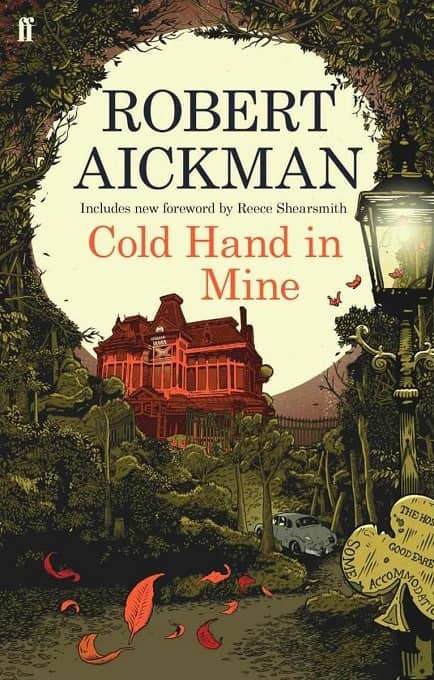 |
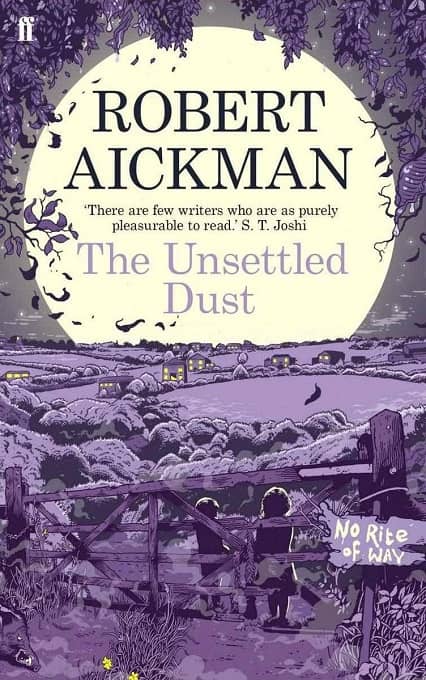 |
The Faber and Faber collected Robert Aickman, published in 2014. Covers by Tim McDonagh
But why is the story called “Marriage”? I think (!), in some weird way, Laming sees his relationship to Helen as a proper, chaste sort of relationship, which should eventually go towards marriage, while Ellen represents, I think, a sort of deeper (and seemingly naughtier) desire that good middle-class wives cannot deliver. And what makes this story even more weird and more ambiguous is that the ending does not make clear whether Laming has returned to Helen or Helen is just an imaginary woman standing in for his mother.
Here are the last few lines. Judge for yourself:
And when they were in bed, her bed [Helen’s? Mumsey’s?], with the windows open and the drawn blinds carelessly flapping, she seemed younger than ever. He knew that she would never change, never disappoint. She did not even need to be thought about.
“Laming,” she said. “You know who loves you best of all.”
He sank into her being.
His leg could be forgotten. The heat could be forgotten. He had sailed into port. He had come home. He had lost and found himself. [p. 221]
Creepy! Especially on a perhaps Oedipus Rex level.
Though The Year’s Best Horror Stories: Series VII would be Page’s last volume in the series, and was clearly not the strongest, nevertheless he had a good run. I think he consistently picked good stories, and often very good to excellent horror ones. I’d buy any anthology (horror or not) that had his name on the cover.
Here’s the complete Table of Contents for The Year’s Best Horror Stories: Series VII:
“Introduction” by Gerald W. Page
“The Pitch” (Whispers, 1978) by Dennis Etchison
“The Night of the Tiger” (Magazine of Fantasy and Science Fiction, 1978) by Stephen King
“Amma” (Beyond the Fields We Know, 1978, ed. Charles de Lint) by Charles Saunders
“Chastel” (for this volume, 1978) by Manly Wade Wellman
“Sleeping Tiger” (Dragonbone, 1978, eds. Charles de Lint and Charles Saunders) by Tanith Lee
“Intimately, with Rain” (Collage, 1978) by Janet Fox
“The Secret” (Impulse: The New Science Fantasy, 1966) by Jack Vance
“Hear Me Now, My Sweet Abbey Rose” (Magazine of Fantasy and Science Fiction, 1978) by Charles L. Grant
“Divers Hands” (for this volume, 1978) by Darrell Schweitzer
“Heading Home” (Whispers, 1978) by Ramsey Campbell
“In the Arcade” (Amazing Science Fiction, 1978) by Lisa Tuttle
“Nemesis Place” (Fantastic, 1978) by David Drake
“Collaborating” (Rooms of Paradise, 1978, ed. Lee Harding) by Michael Bishop
“Marriage” (Tales of Death and Love, 1977) by Robert Aickman
The Year’s Best Horror Stories: Series VII was published by DAW Books in July 1979. It is 221 pages, priced at $1.95. The cover is by Michael Whelan.
Previous installments in this series include:
Introduction To DAW Books’ The Year’s Best Horror Stories (1972–1994)
The Year’s Best Horror Stories: Series I (1972)
The Year’s Best Horror Stories: Series II (1974)
The Year’s Best Horror Stories: Series III (1975)
The Year’s Best Horror Stories: Series IV (1976)
The Year’s Best Horror Stories: Series V (1977)
The Year’s Best Horror Stories: Series VI (1978)
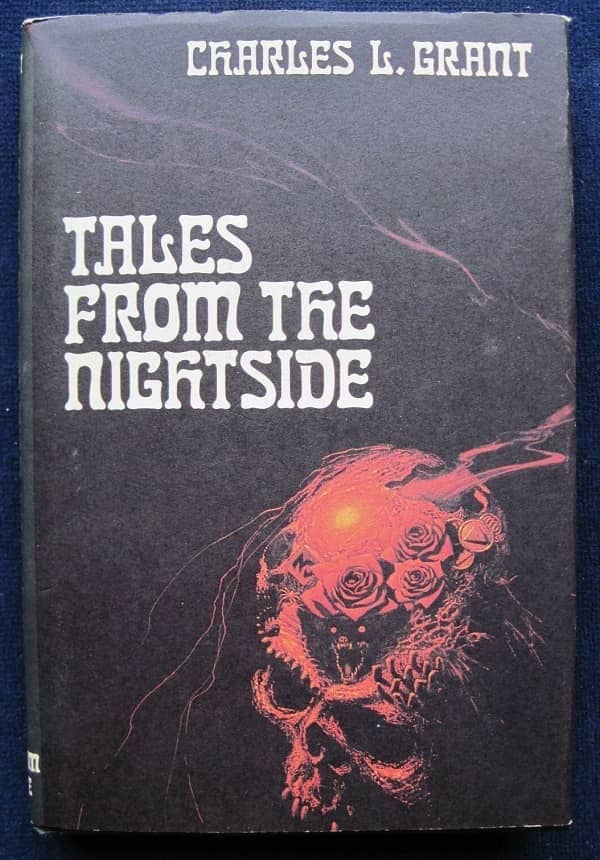
I love Aickman; he’s certainly not for those who demand “The Fast and the Furious,” but that kind of frenetic stuff bores the hell out of me. I like slow burns. It’s all a matter of taste, I suppose.
“Marriage” is one of weirdest stories (in the creepy sense) I’ve ever read. It stays with you long after you’ve read it. I love horror stories that sort of nag away at your brain for days afterwards. Aickman seems to have that knack.
You should really have a go at Cold Hand in Mine, James. I discovered it in an army post library at Camp Casey, South Korea, which in itself is a circumstance almost weird enough for an Aickman story. I would be lying if Isaid that everything of his works for me – sometimes the oblique is just too oblique – but when it works, wow! Cold Hand has two of his very best – The Swords, and especially The Hospice, which has been anthologized in several other places.
I believe the Carter reference on the tombstone is most likely Randolph Carter, a character created by Lovecraft. Whelan did some beautiful cover work for HPL around this same time and Carter definitely made contact with some ghouls in his writings.
You’re probably right — that’s excellent Lovecraftian thinking! I should have thought of the same thing myself.
That is a good catch. I should have thought of that!
You know, it could have been Jimmy Carter, though – he was certainly politically dead by 1979!
LOL — very true! His career was pretty much ended by the failed raid to rescue the Iranian hostages in 1979. He lost to Reagan a year later.
Lapsang souchong is a personal favourite tea – the leaves are smoked and dried over a fire of pine chips or shavings and both the aroma and taste carry the smokiness. Drink it hot and straight, never with milk.
Being Australian, Britishisms in an author’s work come more easily to me.
I too detect a note of humour in Whelan’s cover, as if the ghouls are shocked and possibly terrified at the sight of a living human potential reader staring into their world.
I really like your trawls through this series James, looking forward to the next one.
Thanks Mark. I’m really enjoying going through these old paperbacks. I’m glad others might be enjoying my meanderings.
I’ve been meaning to post and let you know how much I am enjoying the series, James; it was really a great idea. And, of course, you are now about to turn to the book we’ve all been waiting for: the first in the Karl Edward Wagner editing, volume VIII.
Thanks Will! I’m reading that one now. Looking forward to seeing how Wagner changes the direction (if he does) of the series.
I read and reviewed this volume a few years ago, and recall loving the Aickman and Bishop tales. Etchison is very good, but I think the story included was a minor one.
Now that it’s been a few weeks since I read this volume, I don’t remember the Bishop story very well. I recently tracked down an Etchison anthology. Besides one story in it, I couldn’t finish it. He seems to be one of those authors that I really struggle to get into. However, that doesn’t besmirch his clear importance to the field. Aickman though . . . that’s a horror author.